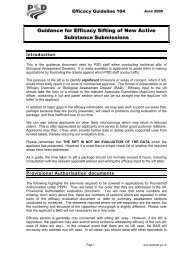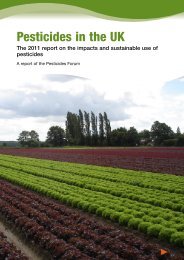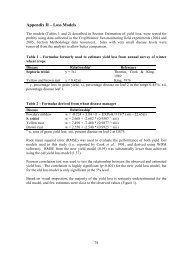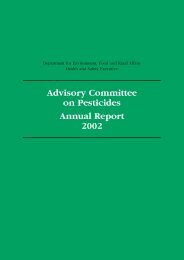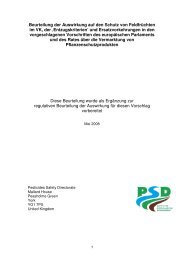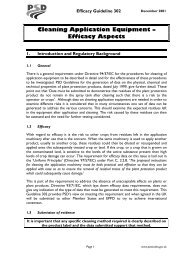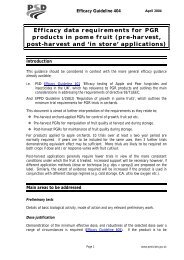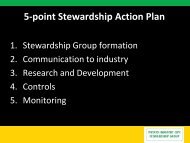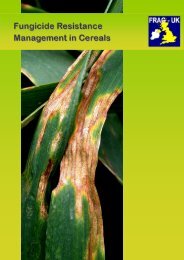Advisory Committee on Pesticides Annual Report 2001
ACP Annual Report 2001 - Pesticides Safety Directorate
ACP Annual Report 2001 - Pesticides Safety Directorate
Create successful ePaper yourself
Turn your PDF publications into a flip-book with our unique Google optimized e-Paper software.
<str<strong>on</strong>g>Advisory</str<strong>on</strong>g> <str<strong>on</strong>g>Committee</str<strong>on</strong>g> <strong>on</strong> <strong>Pesticides</strong> <strong>Annual</strong> <strong>Report</strong> <strong>2001</strong><br />
risk to wildlife and recommended approval for the use <strong>on</strong> winter oilseed<br />
rape as proposed. The <str<strong>on</strong>g>Committee</str<strong>on</strong>g> also recommended that the approval holder<br />
be required to implement a user educati<strong>on</strong> scheme to minimise further any<br />
envir<strong>on</strong>mental effects.<br />
Clomaz<strong>on</strong>e<br />
Clomaz<strong>on</strong>e is a new isoxazolidin<strong>on</strong>e herbicide that acts by inhibiti<strong>on</strong> of<br />
biosynthesis of photosynthetic pigments in plants. The ACP c<strong>on</strong>sidered<br />
applicati<strong>on</strong>s for approval of two products ‘Centium 50 WP’, a wettable powder<br />
(WP), and ‘Centium 360 CS’, a capsule suspensi<strong>on</strong> (CS), for residual c<strong>on</strong>trol<br />
of broad-leaved weeds in winter oilseed rape.<br />
Clomaz<strong>on</strong>e was rapidly and extensively absorbed, metabolised and excreted<br />
in the rat, mainly via urine. Very little unmetabolised parent compound<br />
was excreted and a large number of metabolites were identified,<br />
mostly hydroxylated derivatives of the parent compound, especially<br />
5-hydroxyclomaz<strong>on</strong>e.<br />
8<br />
The active substance is classifiable as ‘Harmful if swallowed and by inhalati<strong>on</strong>’<br />
based <strong>on</strong> acute oral and inhalati<strong>on</strong>al studies in rats.<br />
The <str<strong>on</strong>g>Committee</str<strong>on</strong>g> agreed that the main toxicological effect was liver enlargement<br />
and that the acceptable daily intake (ADI) should be based <strong>on</strong> the no<br />
observed adverse effect level (NOAEL) of 12.5 mg/kg bodyweight (bw)/day)<br />
from a <strong>on</strong>e-year dog study. With a 100-fold assessment factor, this gave an<br />
ADI of 0.13 mg/kg bw/day. It was also c<strong>on</strong>sidered appropriate that the shortterm<br />
systemic admissible operator exposure level (AOEL) should be derived<br />
in the same way. An acute reference dose (ARfD) of 0.3 mg/kg bw/day was<br />
agreed based <strong>on</strong> the NOAEL of 30 mg/kg bw/day for maternal toxicity in a<br />
rabbit teratogenicity study, with a 100-fold assessment factor. Members agreed<br />
that there were no apparent c<strong>on</strong>cerns in relati<strong>on</strong> to genotoxicity,<br />
carcinogenicity or reproductive toxicity.<br />
Residue trials indicated that clomaz<strong>on</strong>e residues were present below the limit<br />
of quantificati<strong>on</strong> (LOQ) in oilseed rape at harvest, and calculati<strong>on</strong>s indicated<br />
that the c<strong>on</strong>sumer exposure would be acceptable. The exposures of operators<br />
from use of ‘Centium 50 WP’ were c<strong>on</strong>sidered acceptable if protective gloves<br />
were worn when handling the product. For ‘Centium 360 CS’ coveralls and<br />
protective gloves should be required when handling the product. Exposures<br />
of bystanders and workers were regarded as acceptable. ‘Centium 360 CS’<br />
was classifiable as a skin sensitiser <strong>on</strong> the basis of a Buehler test, and the ACP




